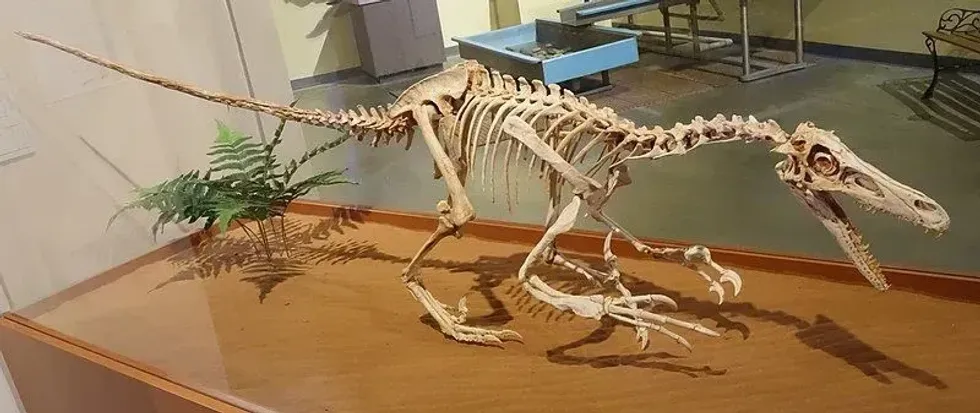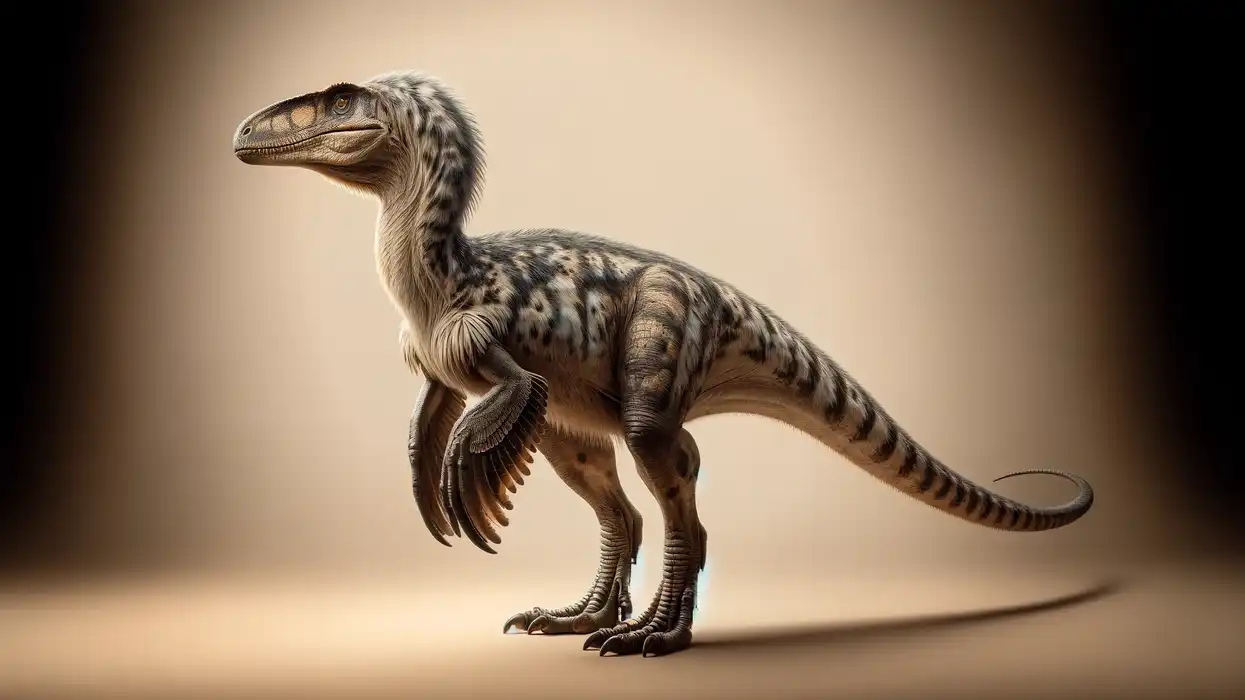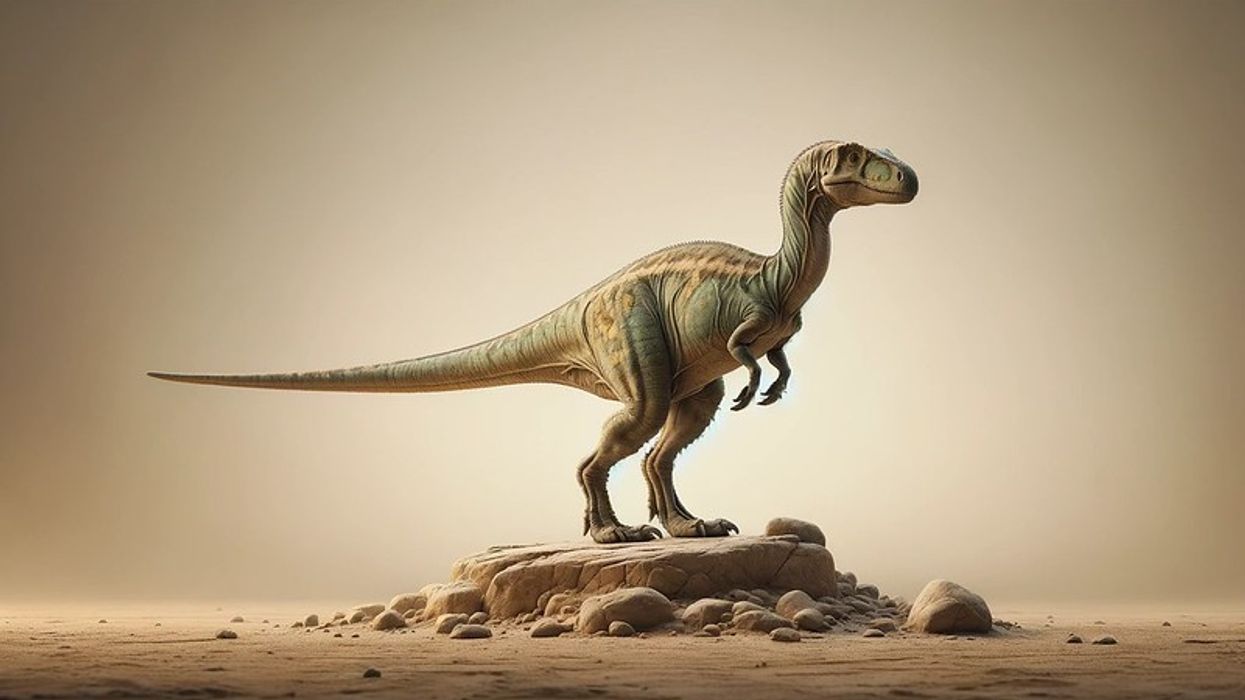Velociraptors, or raptors, are one of the most well-known dinosaurs with a rich and fascinating natural history. This dinosaur also featured in the Jurassic Park movies, however, the depiction was inaccurate. Parts of the Velociraptors' skeleton have been recovered from the Central Asian region. These fossils included the skull and a few other bones of the raptors.
Raptors were known to have a large skull, feathered body, relatively short arms, and sharp claws. The second toe of each foot had a sickle-shaped talon, which was their main weapon.
The short arms of the Velociraptor prevented it from flying, but it had an exceptional running speed. Some theories suggest that Velociraptors hunted in packs.
However, no solid evidence is yet to be established to support this claim. One of the most famous preserved specimens of Velociraptor is named 'Fighting Dinosaurs' and features a Velociraptor locked in combat with a Protoceratops. This fossil has helped paleontologists get an idea about the hunting and killing methods used by the Velociraptors.
Apart from smaller dinosaurs, the diet of a raptor included insects, mammals, and amphibians. Being apex predators, Velociraptors were preyed upon by no one.
To learn more interesting facts about the Velociraptor, keep reading this article! You can also check out Eustreptospondylus and Stokesosaurus.
Velociraptor Interesting Facts
How do you pronounce 'Velociraptor'?
The pronunciation of 'Velociraptor' is 'vel-oss-ee-rap-tor'.
What type of dinosaur was a Velociraptor?
Velociraptor was a type of Therapod dinosaur, belonging to the Dromaeosauridae family. Two species of Velociraptor have been found to date, namely, Velociraptor mongoliensis and Velociraptor osmolskae. The former has been designated as the type species.
In which geological period did the Velociraptor roam the Earth?
It has been discovered that the Velociraptors roamed the Earth 74-70 million years ago. This era constituted the Late Cretaceous age.
When did Velociraptor become extinct?
Looking at the natural history of Velociraptors, these dinosaurs disappeared about 70 million years ago, corresponding to the end of the Late Cretaceous period.
Where did the Velociraptor live?
The first Velociraptor fossil was discovered from the outer Gobi Desert in Mongolia. Subsequent expeditions led to the discovery of more fossils from the Gobi Desert of Southern Mongolia and Northern China. So, these dinosaurs were inhabiting the Central Asian region.
What was the Velociraptor's habitat?
Raptors lived in hot and dry environments, which were desert-like. There may have been some streams in such areas.
Who did Velociraptor live with?
Some scientists postulated that since the preserved fossil specimens of Deinonychus have been found constituting several individuals together, it can be said that Velociraptors also existed and hunted in packs, as they both are related to each other.
However, the counter-argument tells us that no solid evidence exists to support this claim, as all the fossil Velociraptors discovered to date were isolated.
So, the social structure of this bird-like species is still debatable.
How long did a Velociraptor live?
The lifespan of a Velociraptor is estimated to have been about 15-20 years.
How did they reproduce?
Not a lot of information exists about the reproductive nature of Velociraptors. However, some facts have been deduced by scientists.
Raptors reproduced by laying eggs. The female had two oviducts, so they were capable of developing two eggs at a time. It had been theorized that just like any other bird of today, the Velociraptor used its wings and plumage to tend to its nest and protect its eggs.
Velociraptor Fun Facts
What did the Velociraptor look like?

Contrary to the depiction in pop culture, the Velociraptor was actually much smaller in size but had a distinctive appearance, nevertheless. The skull of this dinosaur was relatively large and long, and its shallow, long, and narrow snout was turned in an upward manner.
The jaws were provided with 26-28 teeth on each side, which was spaced out widely and was quite prominently serrated.
Some of the prominent features of the body of Velociraptors are the presence of two large hand-like appendages, each of which has three curved claws. The second toe of each foot was paired with a sickle-shaped and sharp talon.
The use of these talons was related to keeping their prey from escaping, similar to how modern birds of prey use their talons.
Another interesting characteristic of this dinosaur was that it was feathered. The Velociraptor fossil was observed to have quill knobs, which anchored the feathers to the bone. However, the feathers did not aid Velociraptors in flying but may have been used for other purposes.
Lastly, this bipedal dinosaur species had a long tail. The tail bones were hard and fused, preventing horizontal movement due to its stiffness.
How many bones did a Velociraptor have?
Fortunately, the bone structure of Velociraptors is well known to scientists, due to the discovery of more than a dozen fossil skeletons belonging to this dinosaur. However, there is still debate about the exact number of bones possessed by Velociraptors. The young adult fossil specimen tagged IGM 100/982 may have had between 70-100 bones.
How did they communicate?
The exact methods of communication used by Velociraptors have not yet been established. However, Velociraptors were quite intelligent animals. This has been concluded due to the large brain it possessed. So, they could have developed various forms of communication. Additionally, it may have used its plumage as a part of mating or visual display.
How big was the Velociraptor?
The Jurassic Park movies made the Velociraptors much larger than they actually were. In reality, the Velociraptors' size was much smaller.
They had a length of about 6.8 ft (2 m), and a height of 1.6 ft (0.4 m) to the hip. In comparison to Deinonychus, another Theropod, with a length of 11 ft (3.3 m), the Velociraptor was a much smaller animal.
How fast could a Velociraptor move?
Though the Velociraptor was feathered, the feathers did not help in flying. Fossil evidence has shown that the short arms of this species made it impossible for them to fly.
However, Velociraptors were very fast on their two legs. They may have been able to run at a speed of 24 mph (38.6 kph). Some estimates also suggest a speed of 40 mph (64.3 kph).
How much did a Velociraptor weigh?
The weight of a Velociraptor was about 33 lb (15 kg). However, some scientists have suggested a higher weight of 43.4 lb (19.7 kg) for these fascinating animals.
What were the male and female names of the species?
There are no separate names for the male and female dinosaurs of this species.
What would you call a baby Velociraptor?
A baby Velociraptor would be known as a hatchling.
What did they eat?
The bird-like Velociraptor was carnivorous in nature and its diet consisted of small dinosaurs, reptiles, insects, mammals, and amphibians. Herbivorous dinosaurs like Protoceratops were a part of its diet. Velociraptor may have hunted Hadrosaurus, as well. Apart from hunting, Velociraptors probably displayed scavenging behavior, as well.
How aggressive were they?
The Velociraptor has been described as being a combative dinosaur, so they probably were quite aggressive in nature. These dinosaurs used their sharp teeth, claws, and talons to catch their prey.
One of the most famous fossils of Velociraptors to be preserved was found showing the Velociraptor skeleton under a Protoceratops, with a sickle-shaped claw of the raptor lodged in the neck of the Protoceratops.
This specimen has been named, 'Fighting Dinosaurs'. This evidence suggests that the Velociraptors probably killed their prey by using their claws to cut a vital organ of the body or hold down the prey.
Did you know...
The first Velociraptor fossil was discovered by Peter Kaisen, in the year 1923.
The endocranium of the Velociraptor provided an insight into its hearing capabilities. Studies have shown that raptors were capable of hearing sounds in the range of 2,368–3,965 Hz, and hence, could track their prey with ease.
Why are they called Velociraptors?
The name 'Velociraptor' has been taken from Latin, by combining the words 'velox' meaning swift, and 'raptor' meaning robber or thief. This name was given to indicate the speedy nature of this animal, along with its carnivorous diet.
What are three interesting facts about a Velociraptor?
Some of the features that were possessed by Velociraptors that are found in modern birds are the presence of hollow bones, hinged ankles, forward-facing toes, and wishbones.
Recently, the oldest relative of Velociraptor was discovered. It was also a dinosaur covered in feathers and has been given the scientific name Hesperornithoides miessleri.
Paleontologists have concluded that raptors had a warm-blooded metabolism, similar to modern birds and mammals. This conclusion is supported by factors like cold-blooded reptiles aren't good at actively pursuing their prey and Velociraptors had a coat of feathers.
Here at Kidadl, we have carefully created lots of interesting family-friendly dinosaur facts for everyone to discover! Learn more about some other creatures from our Gojirasaurus facts, or Deltadromeus facts for kids.
You can even occupy yourself at home by coloring in one of our free printable family of four dinosaurs coloring pages.
Main image by Jens Lallensack.









